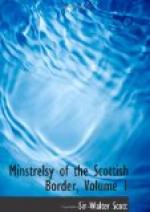John, Lord Maxwell, with whose Goodnight the reader is here presented, was son to him who fell at the battle of Dryffe Sands, and is said to have early vowed the deepest revenge for his father’s death. Such, indeed, was the fiery and untameable spirit of the man, that neither the threats nor entreaties of the king himself could make him lay aside his vindictive purpose; although Johnstone, the object of his resentment, had not only reconciled himself to the court, but even obtained the wardenry of the middle-marches, in room of Sir John Carmichael, murdered by the Armstrongs. Lord Maxwell was therefore prohibited to approach the border counties; and having, in contempt of that mandate, excited new disturbances, he was confined in the castle of Edinburgh. From this fortress, however, he contrived to make his escape; and, having repaired to Dumfries-shire, he sought an amicable interview with Johnstone, under pretence of a wish to accommodate their differences. Sir Robert Maxwell, of Orchardstane (mentioned in the Ballad, verse 1.), who was married to a sister of Sir James Johnstone, persuaded his brother-in-law to accede to Maxwell’s proposal. The two chieftains met, each with a single attendant, at a place called Achmanhill, 6th April, 1608. A quarrel arising betwixt the two gentlemen who attended them (Charles Maxwell, brother to the laird of Kirkhouse, and Johnstone of Lockerby), and a pistol being discharged, Sir James turned his horse to separate the combatants; at which instant Lord Maxwell shot him through the back with a brace of bullets, of which wound he died on the spot, after having for some time gallantly defended himself against Maxwell, who endeavoured to strike him with his sword. “A fact,” saith Spottiswoode, “detested by all honest men, and the gentleman’s misfortune severely lamented, for he was a man full of wisdom and courage.”—SPOTTISWOODE, Edition 1677, pages 467, 504. JOHNSTONI Historia, Ed. Amstael. pp. 254, 283, 449.
Lord Maxwell, the murderer, made his escape to France; but, having ventured to return to Scotland, he was apprehended lurking in the wilds of Caithness, and brought to trial at Edinburgh. The royal authority was now much strengthened by the union of the crowns, and James employed it in staunching the feuds of the nobility, with a firmness which was no attribute of his general character. But, in the best actions of that monarch, there seems to have been an unfortunate tincture of that meanness, so visible on the present occasion. Lord Maxwell was indicted for the murder of Johnstone; but this was combined with a charge of fire-raising, which, according to the ancient Scottish law, if perpetrated by a landed man, constituted a species of treason, and inferred forfeiture. Thus, the noble purpose of public justice was sullied, by being united with that of enriching some needy favourite. John, Lord Maxwell, was condemned, and beheaded, 21st May, 1613. Sir Gideon Murray, treasurer-depute, had a great share of his forfeiture; but the attainder was afterwards reversed, and the honours and estate were conferred upon the brother of the deceased.—LAING’S History of Scotland, Vol. I. p. 62.—JOHNSTONI Historia, p. 493.




